brake pads AUDI R8 SPYDER 2014 Owners Manual
[x] Cancel search | Manufacturer: AUDI, Model Year: 2014, Model line: R8 SPYDER, Model: AUDI R8 SPYDER 2014Pages: 244, PDF Size: 61.06 MB
Page 14 of 244
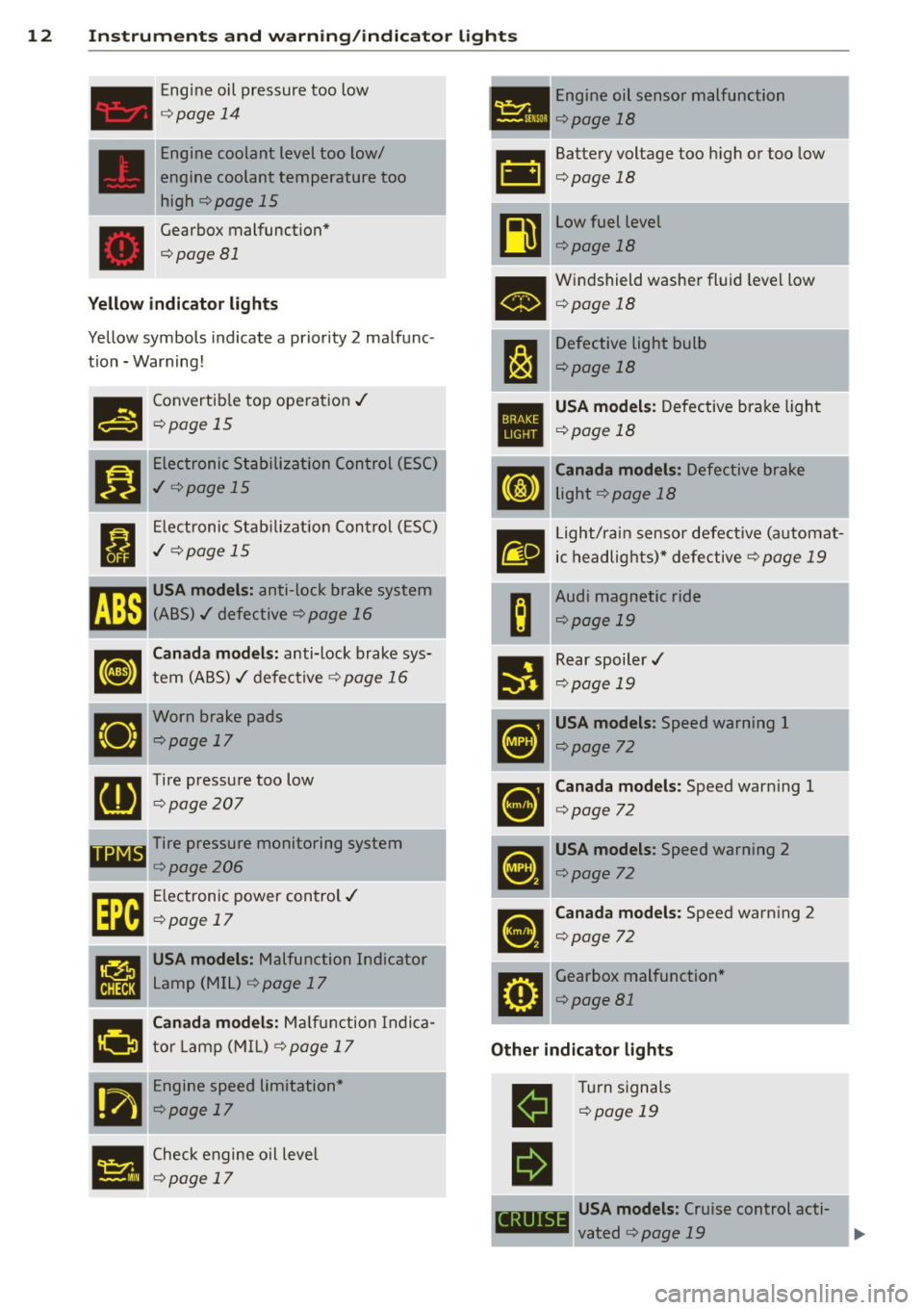
12 Instrum ent s and w arn ing /indic ato r light s
Engine oil pressure too low
¢page 14
Engine coolant level too low/
engine coolant temperature too high
¢page 15
Gearbox malfunction*
¢page 81
Yellow indic ator lights
Yellow symbols indicate a priority 2 malfunc
tion -Warning !
Convertib le top operation ./
¢page 15
Electronic Stabilization Control (ESC)
.f ¢ page 15
Electronic Stab ilizat ion Control (ESC)
.f ¢ page 15
n USA models: anti-lock brake sys tem
~ (ABS) ./ defective ¢ page 16
Canada models : anti-lock brake sys
tem (ABS) ./defective ¢
page 16
Worn brake pads
¢page 17
Tire pressure too low
¢page 207
I Tire pressure monitoring system
11il~, 1 ¢
page206
~ Electronic power control./
~ ¢page17
l!'a USA models: Malfunction Indicator
Bil Lamp (MIL) ¢page 17
Can ad a mo dels: Ma lfunction Indica
tor Lamp (MIL)
¢ page 17
l"ill Engine speed limitation*
lill ¢page17
11111 Check engine oil leve l
lill ¢ page 17
-----
Engine oil sensor malfunction
, ¢page 18
•
Battery voltage too h igh or too low
¢page 18
Low fuel level
¢page 18
• Windshield washer fl
uid level low ¢ page 18
l:J
Defective light bulb
¢page 18
•
USA mod els: Defective brake light
¢ page 18
[ll
Canada models : Defective brake
light¢
page 18
tm
Light/rain sensor defective (automat-
ic headlights)* defective ¢
page 19
B
Audi magnetic ride
¢page 19
--
Ill
Rear spoiler./
¢page 19
•
USA mod els : Speed warning 1
¢page 72
-
•
Canada mod els : Speed warn ing 1
¢ page 72
•
USA model s: Speed warning 2
¢page 72
•
Canad a models : Speed warning 2
¢page 72
rm
Gearbox malfunction*
¢page81
Other indic ator lig ht s
II
II
Turn signals
¢page 19
USA mod els : Cruise control acti-
-
CRUISE
vated ¢ page 19 ll>
Page 15 of 244
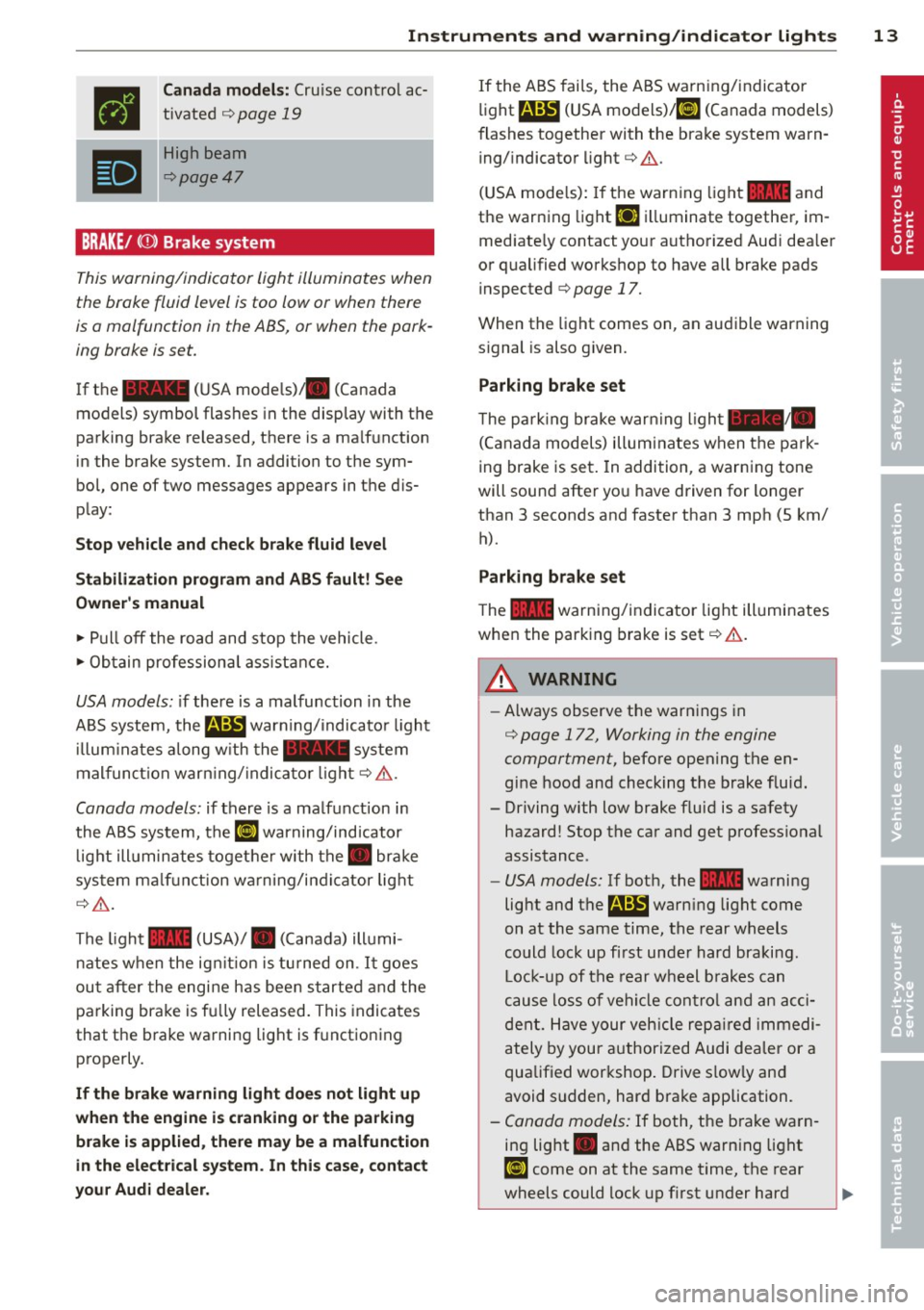
Instrument s and warnin g/indic ator ligh ts 13
•
•
C anada mod els: Cru ise contro l ac
tivated ¢
page 19
High beam
¢page47
BRAKE/ (CD) Brake system
This warning/indicator light illuminates when
the brake fluid level is too low or when there
is o malfunction in the ABS, or when the park
ing brake is set.
I f the - (USA mode ls)/ . (Canada
models) symbol flashes in the display with the
parking brake released, there is a ma lfunction
in the brake system. In addition to the sym
bol, one of two messages appears in the d is
play:
Stop vehicl e and ch ec k brak e fluid le vel
Stabili zati on p ro g ram and AB S fault! Se e
Owne r's manual
"' Pull off the road and stop the vehicle .
"' Ob tain professiona l ass istance.
USA models: if there is a malfunction in the
ABS system, the
B warn ing/indicato r light
i llum inates a long w ith the - system
mal funct ion warning/ indica to r light ¢&. .
Canada models : if there is a malfunction in
the ABS system, the
[iJ warning/indicator
light ill uminates togethe r with the. brake
system ma lf u nction warning/indicator light
¢ &_ .
The light 1111 (USA)/ . (Canada) illumi
n ates when the ig nitio n is tu rned on . It goes
ou t after the engine has bee n started and the
pa rking brake is fu lly released. This indicates
that the brake warning lig ht is functioning
properly.
If the br ake warning li ght do es not light up
w hen the engine i s cranking or the pa rking
bra ke i s a pplied, the re m ay be a malfun ction
in the electric al sy stem. In thi s cas e, cont act
y ou r Au di dealer .
If the ABS fai ls, the ABS warning/indicator
light
B (USA models)/ [iJ (Canada models)
flashes together with the brake system warn
ing/ indicator light ¢&. .
(USA mode ls): If the warning light
1111 and
the warning light
£1 ill uminate together, im
med iate ly contact your authorized Aud i dea ler
or qualified workshop to have all brake pads inspected ¢
page 17.
When the light comes on , an audible warning
s ignal is also g iven.
Parking brake set
T he pa rk ing brake warning ligh t-·
(Canada models) illuminates when the park
ing brake is set . In addition, a warning tone
will sound after yo u have driven for longer
than 3 seconds and faster than 3 mph (5 km/
h).
Parking b ra ke s et
The llll warning/indicator light illuminates
when the parking brake is set¢&. .
_& WARNING
-Always observe the warn ings in
¢ page 172, Working in the engine
compartment,
before opening the en
gine hood and checking the brake f luid.
- Driving with low brake fluid is a safety hazard! Stop the car and get profess ional
assistance .
-USA models: If both, the 1111 warning
light and the
E warn ing light come
on at the same time, the rear wheels
could lock up first unde r hard braking.
Lock-up of the rear wheel b rakes can
cause loss of vehi cle con tro l and an acci
dent. Have your veh icle repa ired immedi
ately by your authorized Audi dealer or a
qualified workshop . Drive s lowly and
avoid sudden, hard brake application.
- Canada models: If both, the b rake warn
ing light . and the ABS warning light
[iJ come on at the same time, the rear
wheels could lock up f irst under hard
~
Page 19 of 244
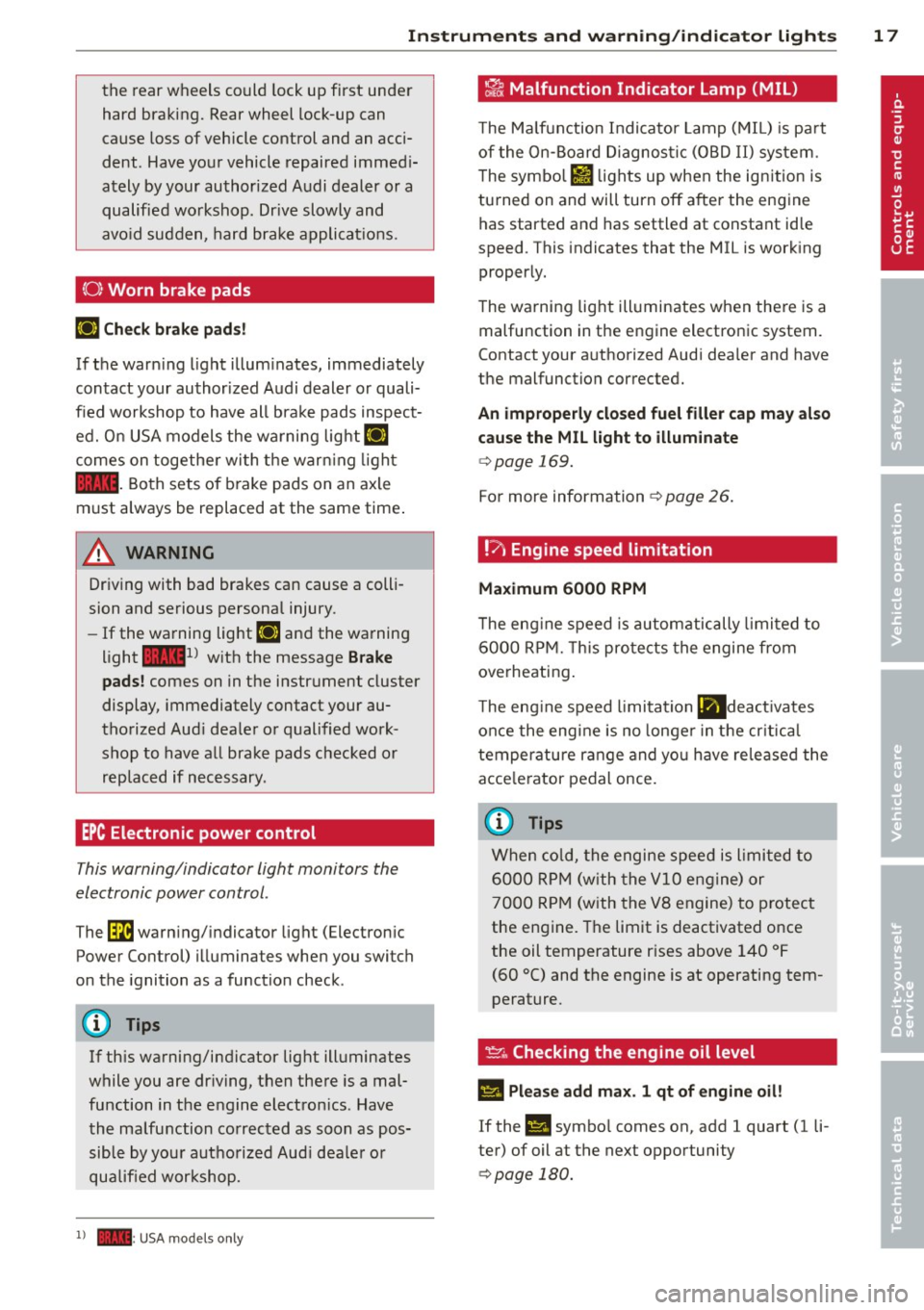
Instrument s and warnin g/indic ator ligh ts 17
the rear wheels could lock up first under
hard braking. Rear wheel lock-up can
cause loss of vehicle control and an acci
dent . Have your vehicle repaired immed i
ately by your authorized Audi dealer or a
qualified workshop. Dr ive slowly and
avo id sudden, hard brake applicat ions.
(0 ) Worn brake pads
IJ Che ck brake pad s!
If the warn ing light illum inates, immediately
contact your author ized Audi dealer or quali
fied workshop to have all bra ke pads inspect
ed. O n USA models the wa rning lig ht
IJ
comes on togethe r wi th the warn ing light
1111 . Both sets of brake pads on an axle
must always be replaced at the same time .
& WARNING
Driving with bad brakes can cause a colli
sion and serious personal injury.
- If the wa rning light IJ and the warning
l ight
11111
) w ith the message B rake
pads !
comes on in the instrument cluster
display, immediately contact your au
thorized Aud i deale r or qualified work
shop to have all brake pads checked or replaced if necessary .
EPC Electronic power control
This warning/indicator light monitors the
electronic power control .
The~ warn ing/ indicator light (Electron ic
Power Control) illuminates when you switch
on the ignition as a function check .
(D) Tips
If this warning/indicator light ill uminates
while you are dr iving, then there is a mal
function in the engine electron ics . Have
the malfunction co rrected as soon as pos
sible by you r authorized Aud i dea le r or
qualified workshop.
1) - : USA mod els on ly
-
~ Malfunction Indicator Lamp (MIL)
T he Ma lfunction Indi cato r Lamp ( MIL) is pa rt
of the On-Board Diagnos tic (OBD II) system .
T he symbo l
fl lights up when the ign ition is
turned on and will turn off after the eng ine
has started and has settled at constant id le
speed . This indicates that the MIL is work ing
properly.
T he warning lig ht ill uminates when there is a
malfunction in the engine electronic system .
Contact your a uthori zed Aud i dea ler and have
the malfunction corrected.
An improperly clo sed fuel filler cap may al so
cause the MIL l ight to illum inate
¢ page 169.
For more information ¢ page 26 .
!7, Engine speed limitation
Ma ximum 6000 RPM
T he eng ine speed is automatically limited to
6 000 RP M. T his pro tects the engine fr om
overheating .
T he eng ine speed limitation
lll deact ivates
once the eng ine is no longe r in t he cr itica l
tempe rature range and you have released the
acce le rator pedal once.
(D Tips
When co ld, the engine speed is l imited to
6000 R PM (w ith the
VlO engine) or
7000 R PM (with the VB engine) to p rotect
the engine. The limit is deactivated once
the oil temperature r ises above 140 °F
(60 °C) and the engine is at operating tem
perature .
~ .. Checking the engine oil level
II Please add ma x. 1 qt of engine oil!
If the II symbo l comes on, add 1 quart (1 li
ter) of oil at the next opportunity
¢ page 180.
Page 77 of 244
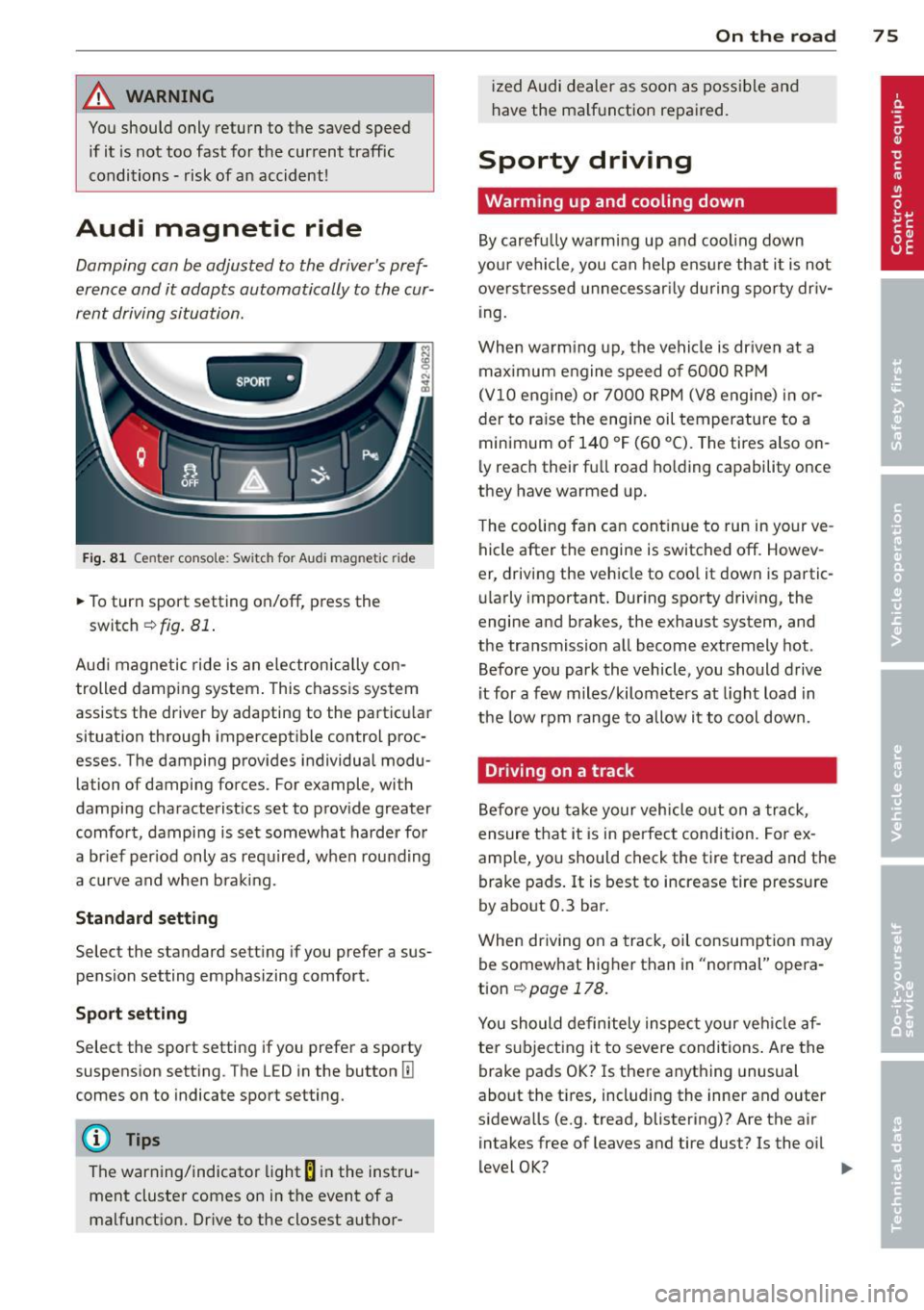
_& WARNING
You should only return to the saved speed if it is not too fast for the current traffic
conditions - risk of an accident!
Audi magnetic ride
Damping can be adjusted to the driver's pref
erence and it adapts automatically to the cur
rent driving situation.
SPORT •
Fig. 81 Center conso le : Switch for Audi magnetic ride
.,. To turn sport setting on/off, press the
switch
¢fi g. 81 .
Aud i magnetic ride is an electronica lly con
trolled damping system . This chassis system
assists the driver by adapting to the particu lar
situation through imperceptible control proc
esses. The damping provides individual modu
lation of damping forces. For example, with
damping characteristics set to prov ide greater
comfort, damping is set somewhat harder for
a brief period only as required, when rounding
a curve and when brak ing.
Standard setting
Select the standard setting if you prefer a sus
pension setting emphasizing comfort.
Sport setting
Select the sport setting if you prefer a sporty
suspension setting. The LED in the button
II]
comes on to indicate sport setting.
@ Tips
The warning/indicator light Bin the instru
ment cluster comes on in the event of a
malfunction. Drive to the closest author-
On the road 75
ized Audi dealer as soon as possible and
have the malfunction repaired.
Sporty driving
Warming up and cooling down
By carefully warming up and cooling down
you r vehicle, you can help ensure that it is not
overstressed unnecessar ily during sporty driv
ing .
When warm ing up, the vehicle is driven at a
maximum engine speed of 6000 RPM
(Vl0 engine) or 7000 RPM (V8 engine) in or
der to raise the engine oil temperature to a
minimum of 140 °F (60 °C). The tires also on
ly reach their full road holding capability once
they have warmed up.
The cooling fan can cont inue to run in your ve
hicle after the engine is switched off. Howev
er, driving the vehicle to coo l it down is partic
ularly important. During sporty driving, the
engine and brakes, the exhaust system, and
the transmission all become extremely hot.
Before you park the vehicle, you should drive
it for a few m iles/kilometers at light load in
the low rpm range to allow it to cool down.
Driving on a track
Before you take your vehicle out on a track ,
ensure that it is in perfect condition. For ex
amp le, you should check the tire tread and the
brake pads. It is best to increase tire pressure
by about 0.3 bar.
When driving on a track, oil consumption may
be somewhat higher than in "normal" opera
tion
r=> page 178.
You should definitely inspect your vehicle af
ter subject ing it to severe conditions . Are the
brake pads OK? Is there anything unusual
about the tires, including the inner and outer
sidewalls (e.g. tread, blistering)? Are the air
intakes free of leaves and tire dust? Is the oil
level OK? .,,.
Page 148 of 244

146 Intelligent technology
ESC sport mode
In ce rtain situat ions, it migh t make sense to
a llow some slip. For example :
- Rocking the vehicle to free it when it is stuck
- Driving in deep snow or on loose ground
- Driving with snow cha ins
Press the[!] button briefly¢
fig. 128 . The I
indicator light turns on and Sport control
Warning! Restricted stability
appears in the
driver information system display . Driving sta
b ili ty is limited in sport mode .
Switching ESC off
Press and hold the [!I button for three sec
onds . The ESC indicator light
ti turns on and
Stabilization program off appears in the dis
play. ASR is also sw itched
off when ESC is
switched
off .
Switching on
Press the[!] button aga in. The message Stabi
lization program on
appears briefly in the d is
play.
A WARNING
You should only switch the ESC off if your
driving ability and the traffic s ituation al
low. This could increase the risk of slip
ping.
- The stabilizing function is limited in ESC
sport mode. The driv ing whee ls could
spin and the vehicle could swerve, espe
cially on slick or slippery road surfaces.
- T here is no vehicle stabilization when
E SC is switched
off.
0) Tips
If there is a malfunction in the retractable
rear spo iler* or the Audi magnet ic r ide*, it
may not be possible to activate ESC spo rt
mode or normal mode may activate again
automatically.
Braking
General information
What affects braking efficiency?
New brake pads
During the first 250 miles (400 km), new
brake pads do not possess their full braking
effect, they have to be "broken in" first. The
distance can be ten times longer in vehicles
with ceramic brakes*. You can compensate for
th is slightly reduced braking power by push
ing harder on the brake pedal. Avoid heavy
braking loads during the break-in period.
Operating conditions and driving habits
The brakes on today's automobiles are still
subject to wear, depending largely on operat
ing condit ions and driving habits ¢.&, . On
vehicles that are either driven mostly in stop
and-go city traffic or are driven hard, the
brake pads should be checked by your author
ized Audi dea ler more often than specified in
the
Warranty & Maintenance booklet. Failure
to have your brake pads inspected can result
in reduced brake performance.
On steep slopes, you should use the braking
effect of the engine. This way, you prevent un
necessary wear on the brake system. If you
must use your brakes, do not hold the brakes
down cont inuously. Pump the brakes at inter
vals.
Moisture o r road salt
Under certain conditions, for example, when
driving through water or very heavy rain, or
even after washing your vehicle, the braking
effect can be reduced due to moisture (or in
freezing conditions ice) on the brake pads . A
few cautious brake applications should dry
off
the brake pads or remove any ice coatings .
When you are driving at higher speeds with
the windshield wipers on, the brake pads will briefly touch the brake discs in regular inter
vals so as to improve reaction time when brak
i ng on wet surfaces. You, the driver, will not
notice anything. .,.
Page 149 of 244
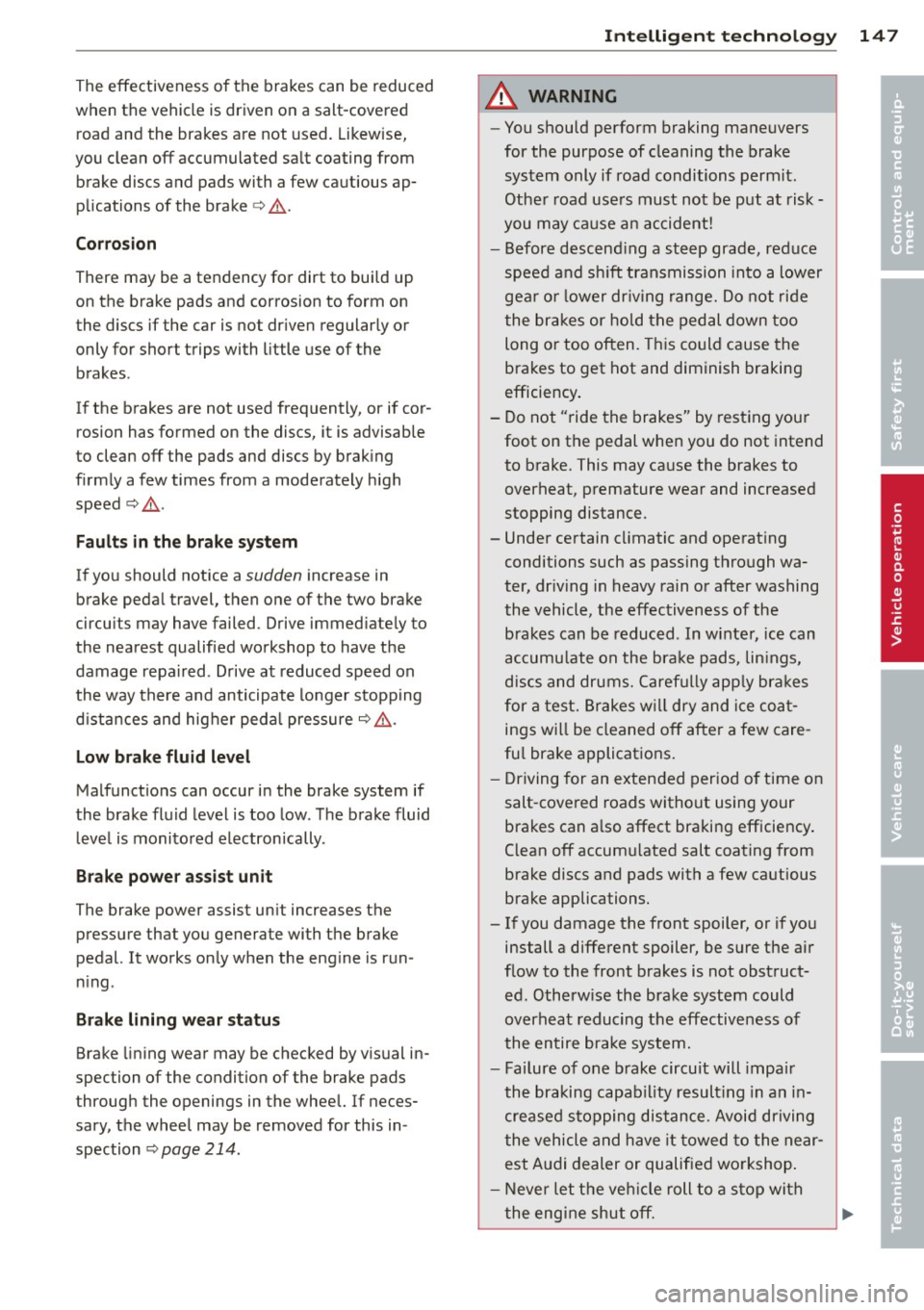
The effectiveness of the brakes can be reduced
when the vehicle is dr iven on a salt -covered
road and the brakes are not used. Likewise,
you clean
off accumulated salt coating from
brake discs and pads with a few ca utious ap
plications of the brake<=>,& .
Co rrosion
There may be a tendency for dirt to build up
on the brake pads and corrosion to form on
the discs if the car is not dr iven regularly or
only for short trips with little use of the
brakes.
If the brakes are not used frequently, or if cor rosion has formed on the discs, it is advisable
to clean
off the pads and discs by brak ing
firmly a few times from a moderately high
speed<=> ,&.
Fa ult s in th e bra ke s yste m
If you should notice a sudden increase in
brake pedal travel, then one of the two brake
circu its may have failed. Drive immed iately to
the nearest qualified workshop to have the
damage repa ired. Drive at reduced speed on
the way there and anticipate longer stopping
d istances and higher peda l pressure¢ _&.
Low brake fluid level
Malfunctions can occur in the brake system if
the brake flu id level is too low . The brake fluid
l eve l is monito red electronically .
Brake po wer ass ist un it
The brake power assist un it increases the
pressure that you generate with the brake
pedal. It works only when the eng ine is run
ning.
Br ake lining w ear statu s
Brake lining wear may be checked by visual in
spection of the condition of the brake pads
through the openings in the wheel. If neces
sary, the wheel may be removed for this in
spection
¢ page 214 .
Int ellig ent technolog y 147
_& WARNING
-You should perform braking maneuvers
for the purpose of cleaning the brake
system only if road conditions permit.
Other road use rs must not be put at risk -
you may ca use an accident!
- Before descend ing a steep grade, reduce
speed and sh ift transmission into a lower
gear o r lower dr iving range. Do not ride
the brakes or hold the pedal down too
long o r too often. Th is could cause the
brakes to get hot and diminish braking
efficiency .
- Do not " ride the brakes" by resting you r
foot on the pedal when you do not intend to brake. This may cause the brakes to
overheat, premature wear and increased
stopping distance.
- Under certain cl imatic and operat ing
conditions such as passing through wa
ter, dr iv ing in heavy rain o r after washing
the vehicle, the effectiveness of the brakes can be reduced. In winte r, ice can
accumu late on the bra ke pads, lin ings,
discs and drum s. Carefully app ly bra ke s
for a test. Brakes w ill dry and ice coa t
ings w ill be cleaned
off after a few care
fu l brake applications.
- Driving for an extended period of time on
salt -cove red roads without using your
brakes can a lso affect braking efficiency .
Clean
off accum ulated salt coating from
brake discs and pads with a few cautious
brake applications.
- I f you damage the front spoiler, or if you
install a different spoiler, be sure the air
f low to the front brakes is not obstruct
ed. Otherw ise the brake system could
overheat reducing the effectiveness of
the entire brake system.
- Failure of one b rake circuit will impai r
the braking capab ility result ing in an in
creased stopping distance. Avoid driving
the vehicle a nd have it towed to the near
est A udi dealer or qualified workshop .
- Never let the veh icle roll to a s top with
the engine shut
off. .,.
•
•
Page 155 of 244
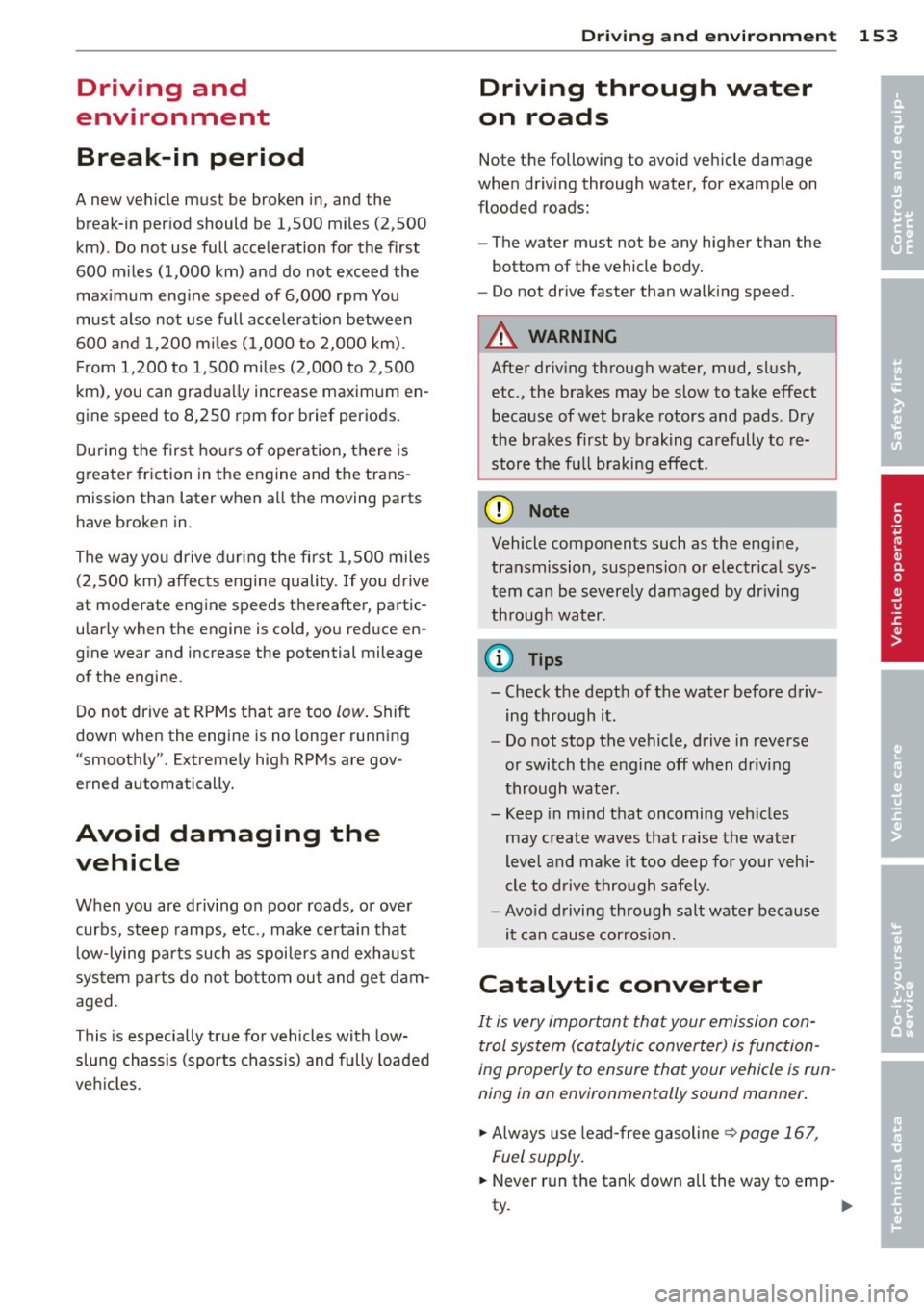
Driving and
environment
Break-in period
A new vehicle must be broken in, and the
break-in period should be 1,500 miles (2,500
km) . Do not use full acceleration for the first
600 m iles (1,000 km) and do not exceed the
maximum engine speed of 6,000 rpm You
must also not use full accelerat ion between
600 and 1,200 mi les (1,000 to 2,000 km).
Fr om 1,200 to 1,500 miles (2,000 to 2,500
km), you can gradua lly increase maximum en
gine speed to 8,250 rpm for brief periods.
During the first hours of operation, there is
greater friction in the engine and the trans
mission than later when all the moving parts
have broken in.
The way you drive during the first 1,500 miles
(2,500 km) affects engine quality. If you drive
at moderate eng ine speeds thereafter, partic
ularly when the engine is cold, you reduce en
gine wear and increase the potential mileage
of the engine.
Do not drive at RPMs that are too
low. Shift
down when the engine is no longer running
"smoothly". Extreme ly high RPMs are gov
erned automatically.
Avoid damaging the
vehicle
When you are driving on poor roads, or over
curbs, steep ramps, etc., make certain that
low-lying parts such as spoilers and exhaus t
system parts do not bottom out and get dam
aged.
This is especially true for vehicles with low
slung chassis (sports chassis) and fully loaded
veh icles.
Driving and environment 153
Driving through water
on roads
Note the following to avoid vehicle damage
when driving through water, for example on
flooded roads:
- The water must not be any higher than the
bottom of the vehicle body.
- Do not drive faster than walking speed .
A WARNING
After driving through water, mud, slush,
etc ., the brakes may be slow to take effect
because of wet brake rotors and pads . Dry
the brakes first by braking carefully to re
store the full braking effect.
(D Note
Vehicle components such as the eng ine,
transmission, suspension or electrical sys
tem can be severe ly damaged by dr iv ing
th rough water.
(D Tips
- Check the depth of the water before d riv
ing through it.
- Do not stop the vehicle, drive in reverse
or switch the engine off when driving
through water.
- Keep in mind that oncoming vehicles
may create waves that ra ise the water
level and make it too deep for your vehi
cle to drive through safely.
- Avo id driving through salt water because
it can cause corrosion.
Catalytic converter
It is very important that your emission con
trol system (catalytic converter) is function
ing properly to ensure that your vehicle is run
ning in on environmentally sound manner .
.,. Always use lead-free gasoline ~ page 167,
Fuel supply .
.,. Never run the tank down all the way to emp-
~. ~
•
•
Page 234 of 244
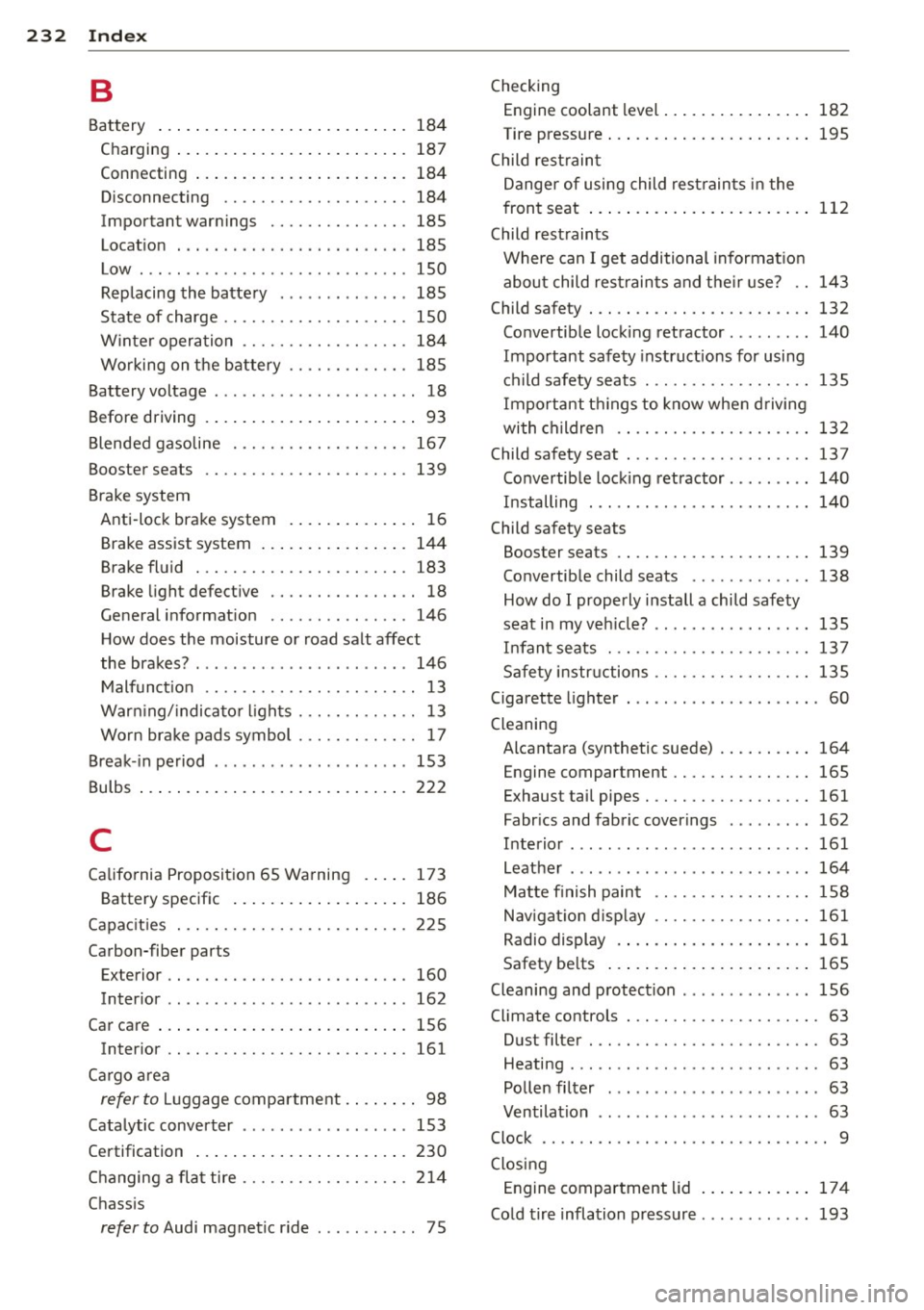
232 Index
B
Battery .......... ......... ... .... .
Charging ... .. .............. ..... .
Connecting ................. ..... .
Disconnecting ............... .... .
Important warnings ...... .... .... .
Location
. ...... .... ..... .... .. .. .
184
187
184
184
185
185
Low ..... .. ............ ... .. .. ... 150
Replacing the battery ...... ... .. .. . 185
State of charge ........... .. .. .. .. . 150
W inter operation ......... .. .. .... . 184
Working on the battery .. .. .. .. .. .. . 185
Battery voltage . . . . . . . . . . . . . . . . . . . . . . 18
Before driving . . . . . . . . . . . . . . . . . . . . . . . 93
Blended gasoline
Booster seats
Brake system 167
139
Anti-lock brake system ..... ... .... .. 16
Brake assist system ........ ... .... .
Brake fluid
.................. .....
144
183
Brake light defective . . . . . . . . . . . . . . . . 18
General information ...... .. .. .. .. . 146
How does the moisture or road salt affect
the brakes? ... .. ...... .... ... .. .. . 146
Malfunction ............. .... ...... 13
Warn ing/ indicator lights ....... .. .. . . 13
Worn brake pads symbol . . . . . . . . . . . . . 17
Break -in period . .......... ... .. .. ... 153
Bulbs .. ... .................. ..... . 222
C
California Proposition 65 Warning . ... . 173
Battery specific . . . . . . . . . . . . . . . . . . . 186
Capac it ies . ................. .. .. .. . 225
Carbon-fiber parts Exterior · · ............... .. .. .. .. . 160
Inter ior .. .. ... .... ...... ... ... .. . 162
Car care ..... ................ ..... . 156
Inter ior ...... ........... .. .. .... . 161
Cargo area
refer to Luggage compartment . . . . . . . . 98
Catalytic converter ........ ... .. .. .. . 153
Certification ................. ..... . 230
Changing a flat tire ....... .. .. .. .. .. . 214
Chassis
refer to Audi magnetic ride ... .. .. .. . . 75 Checking
Engine coolant level
................
Tire pressure ... .. ................ .
Child restraint
Danger of using child restraints in the
front seat
. .... .. ................ .
Child restraints
Where can I get additional informat ion
about child restraints and the ir use? ..
Child safety . .... .. ... .......... ... .
Convertible locking retractor . .. .. .. . .
Important safety instructions for using
child safety seats . ... .......... .. . .
Important things to know when driving
with children
................. ....
Child safety seat . .. ... ......... ... . .
Convertible locking retractor .. ... .. . .
Installing . .. .. .. .... .... ..... .. . .
Child safety seats Booster seats
................. ....
Convertible child seats .......... ...
How do I properly install a child safety
seat in my veh icle? ...... ....... .. . .
Infant seats
......... ' . ' . ' ' . ' .....
182
195
112
143
132
140
135
132
137
140
140
139
138
135
137
Safety instructions ... .......... .. .. 135
Cigarette lighter . . . . . . . . . . . . . . . . . . . . . 60
Cleaning Alcantara (synthetic suede) .......... 164
Engine compartment . . . . . . . . . . . . . . . 165
Exhaust tail pipes .................. 161
Fabrics and fabric coverings .. ... .. .. 162
Interior ....... .. ..... ..... ... .. .. 161
Leather . .. ... ... ... ......... ... .. 164
Matte finish paint ............. .... 158
Nav igat ion d isplay ............... .. 161
Radio display .... ................ . 161
Safety belts ... .. ................ . 165
Cleaning and protect ion . ...... ... .. . .
Climate controls
.....................
156
63
Dust filter . . . . . . . . . . . . . . . . . . . . . . . . . 63
Heating . . . . . . . . . . . . . . . . . . . . . . . . . . . 63
Pollen filter . . . . . . . . . . . . . . . . . . . . . . . 63
Ventilation . . . . . . . . . . . . . . . . . . . . . . . . 63
Clock
............................... 9
Closing
Engine compartment lid ......... ... 17 4
Cold tire inflation pressure ..... ... .. .. 193